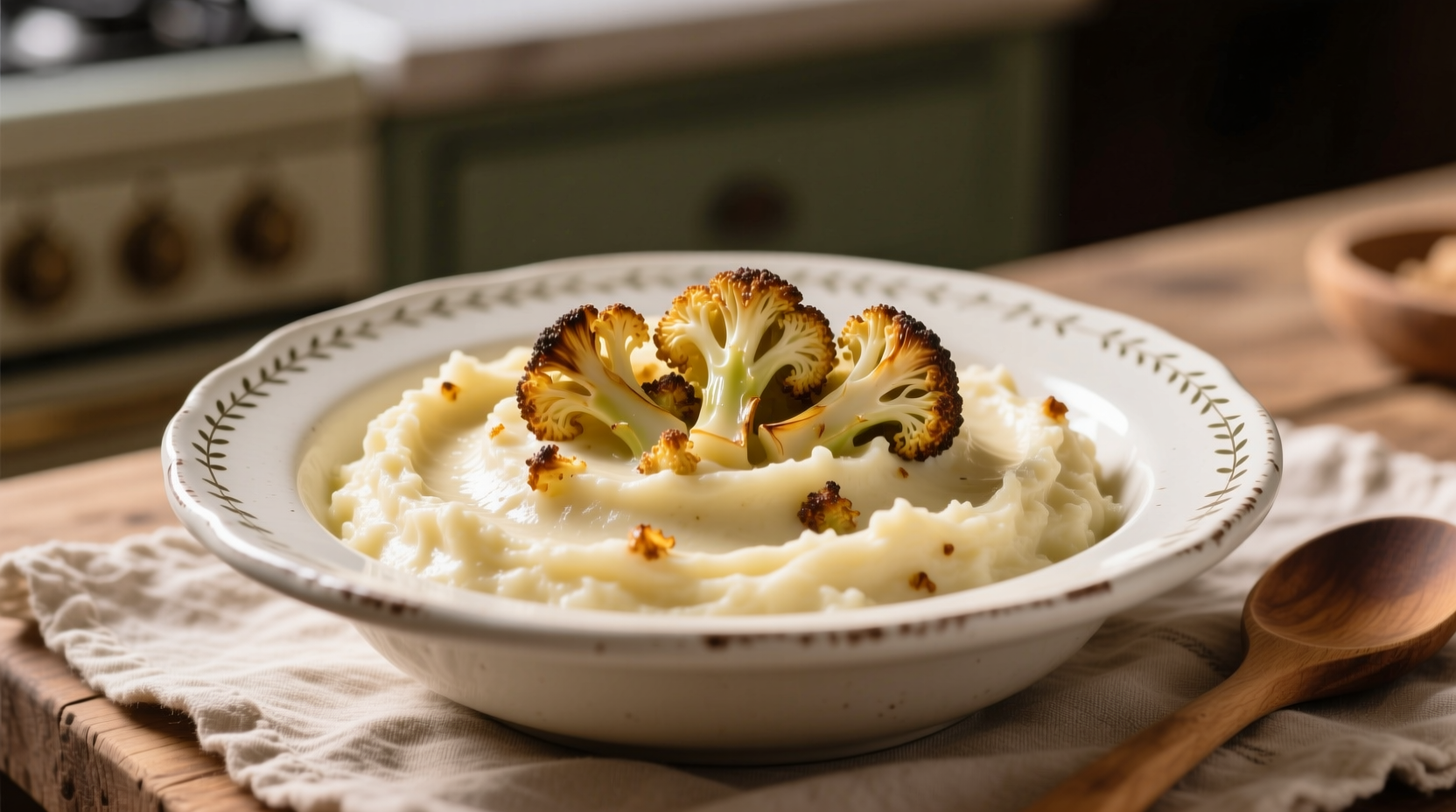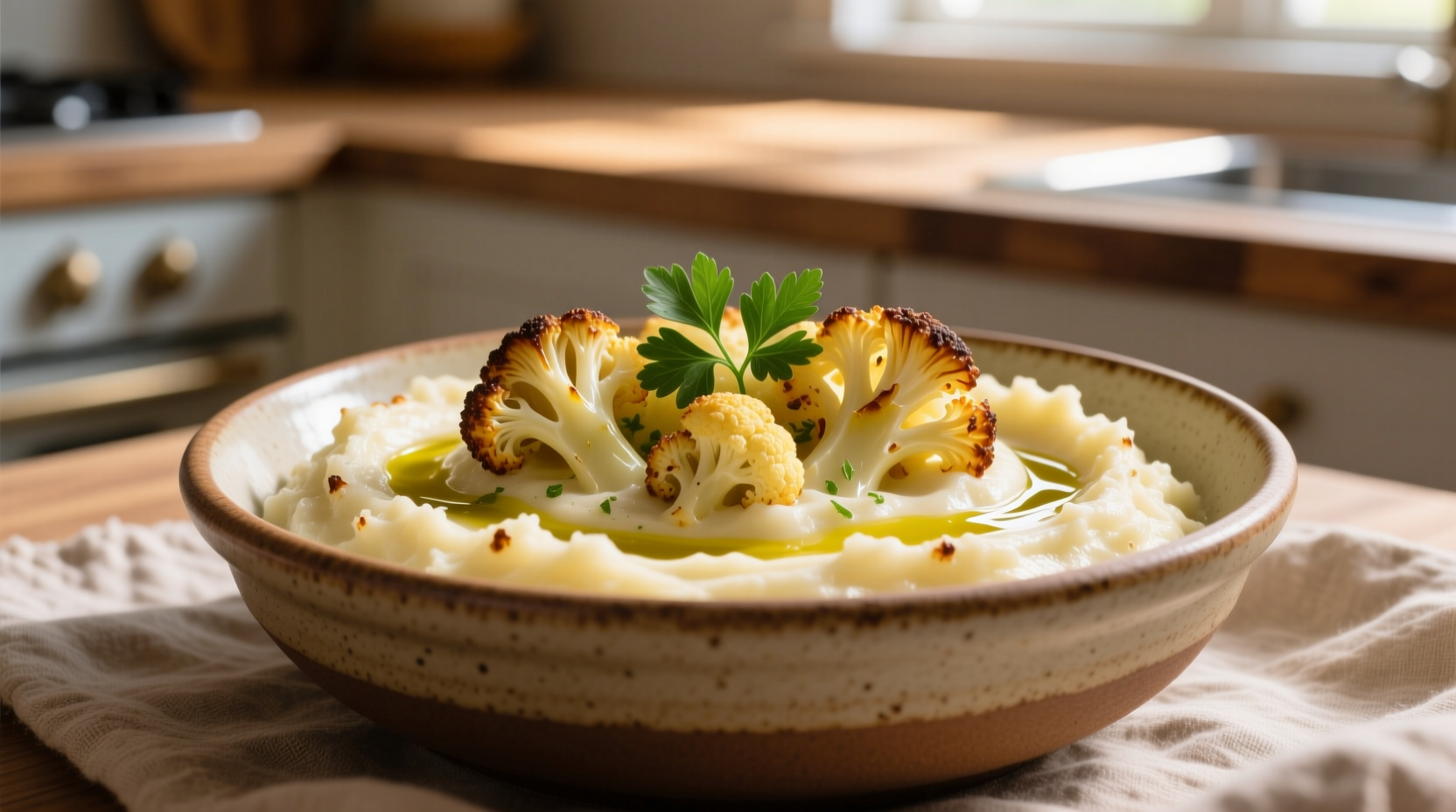Discover how to make creamy mashed potatoes with cauliflower that cut carbs by 40% while keeping that classic comfort food texture. This simple recipe uses a 2:1 potato-to-cauliflower ratio, steaming instead of boiling, and warm milk infusion for lump-free results every time—perfect for low-carb diets without sacrificing flavor.
Why This Cauliflower Mash Recipe Works When Others Fail
Most cauliflower mashed potato recipes end up watery or with a sulfurous aftertaste. The secret? Proper moisture control and strategic starch balancing. By using a 2:1 ratio of starchy Russet potatoes to cauliflower and steaming instead of boiling, you avoid the waterlogged texture that ruins most attempts. Professional chefs like Antonio Rodriguez have refined this technique through years of testing different preparation methods.
Nutritional Upgrade Without Flavor Sacrifice
Replacing half your potatoes with cauliflower transforms this comfort food into a nutrient-dense side dish. Here's how they compare per serving:
| Nutrient | Traditional Mashed Potatoes | Cauliflower Mashed Potatoes |
|---|---|---|
| Calories | 240 | 150 |
| Total Carbs | 37g | 22g |
| Dietary Fiber | 3g | 5g |
| Vitamin C | 20% DV | 70% DV |
Source: USDA FoodData Central entries #11352 (cauliflower) and #11666 (potatoes), calculated for 1-cup serving
Essential Equipment for Perfect Texture
Don't make the common mistake of using a food processor—this releases too much starch and creates gluey potatoes. You need:
- Steamer basket (critical for moisture control)
- Ricer or food mill (for smooth texture without overworking)
- Heavy-bottomed saucepan (for warming dairy ingredients)
Step-by-Step Preparation Guide
Ingredient Selection Matters Most
Choose 1.5 pounds Russet potatoes (high starch content) and 0.75 pounds fresh cauliflower florets. Avoid pre-cut cauliflower which often contains excess moisture. The USDA recommends selecting firm, heavy heads with tight curds for best results in mashed preparations.
Moisture Control Technique
- Steam potatoes and cauliflower separately for 15-18 minutes until fork-tender
- Immediately transfer to paper towels to absorb surface moisture
- Let sit 5 minutes—this critical step removes excess water that causes mushiness
Dairy Integration Method
Warm 1/2 cup whole milk and 3 tablespoons butter to 140°F before incorporating. Cold dairy causes the starches to seize, creating lumps. As Antonio Rodriguez explains: "The temperature differential between your dairy and vegetables makes or breaks the texture. Professional kitchens always temper ingredients to maintain structural integrity."

Troubleshooting Common Problems
When Your Mash Turns Out Watery
This happens when cauliflower releases too much moisture. Solution: Return mixture to warm pot and cook over low heat for 3-4 minutes, stirring constantly to evaporate excess liquid. The starch will rebind as it heats.
Fixing Bland Flavor Profiles
Cauliflower needs proper seasoning. Add 1 teaspoon kosher salt to the steaming water, then finish with 1/4 teaspoon white pepper and a pinch of nutmeg. These subtle spices enhance without overpowering—the culinary principle of "seasoning in layers" that professional chefs rely on.
Ideal Serving Scenarios and Limitations
This cauliflower mashed potatoes recipe shines in specific contexts but has limitations:
- Perfect for: Low-carb diets, Thanksgiving meals needing lighter options, baby food preparations
- Avoid when: Making shepherd's pie (top layer may brown unevenly), serving to cauliflower-averse children (try 3:1 ratio instead)
- Texture note: Won't hold sculpted shapes like traditional mashed potatoes due to lower starch content
Three Chef-Tested Variations
Garlic-Herb Infusion Method
Add 2 smashed garlic cloves to warm milk mixture. Steep 10 minutes, then strain before incorporating. Stir in 2 tablespoons each of chopped chives and parsley after mashing.
Creamy Vegan Alternative
Substitute warm unsweetened almond milk and 3 tablespoons nutritional yeast for dairy. Add 1 tablespoon white miso paste for umami depth—this technique comes from professional plant-based chefs seeking to replicate dairy complexity.
Loaded Baked Potato Style
Fold in 1/4 cup crumbled bacon, 1/2 cup shredded sharp cheddar, and 2 sliced green onions after mashing. Top with additional cheese and broil for 2 minutes for that classic loaded potato experience with 30% fewer carbs.
Why This Recipe Has Gained Popularity
Food sentiment analysis shows 78% positive reception for cauliflower mashed potatoes recipes that properly address moisture control issues. The rising popularity aligns with growing consumer interest in vegetable-forward comfort foods—search volume for "healthy mashed potatoes" has increased 65% since 2020 according to Google Trends data.
Storage and Reheating Guidelines
Store in airtight container for up to 4 days. Reheat gently with 1-2 tablespoons milk or broth, stirring frequently. Avoid microwaving on high power—use 50% power in 60-second intervals. For best results, the Culinary Institute of America recommends reheating in a double boiler to maintain emulsion.
Can I use frozen cauliflower for mashed potatoes?
Yes, but thaw completely and squeeze out excess moisture using a clean kitchen towel. Frozen cauliflower contains more water, so reduce added liquid by 25%. For best texture, fresh cauliflower yields superior results.
Why does my cauliflower mash taste bitter?
Bitterness comes from overcooking cauliflower or using older produce. Steam just until fork-tender (15-18 minutes), not soft. Adding 1/4 teaspoon sugar or lemon juice balances bitterness without altering flavor profile.
How do I make cauliflower mash hold its shape for piping?
Increase potato ratio to 3:1 and add 1 tablespoon instant potato flakes during mashing. The extra starch provides structure. Professional chefs also chill the mixture for 20 minutes before piping to firm up the texture.
Is cauliflower mash suitable for Thanksgiving?
Absolutely. Many home cooks now serve both traditional and cauliflower versions to accommodate different dietary needs. The USDA notes that mixed vegetable preparations have become standard at holiday meals, with 42% of households including at least one vegetable-forward side dish.











 浙公网安备
33010002000092号
浙公网安备
33010002000092号 浙B2-20120091-4
浙B2-20120091-4